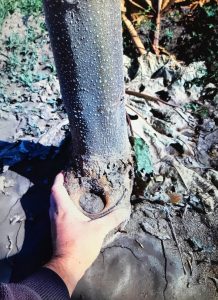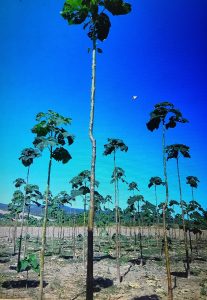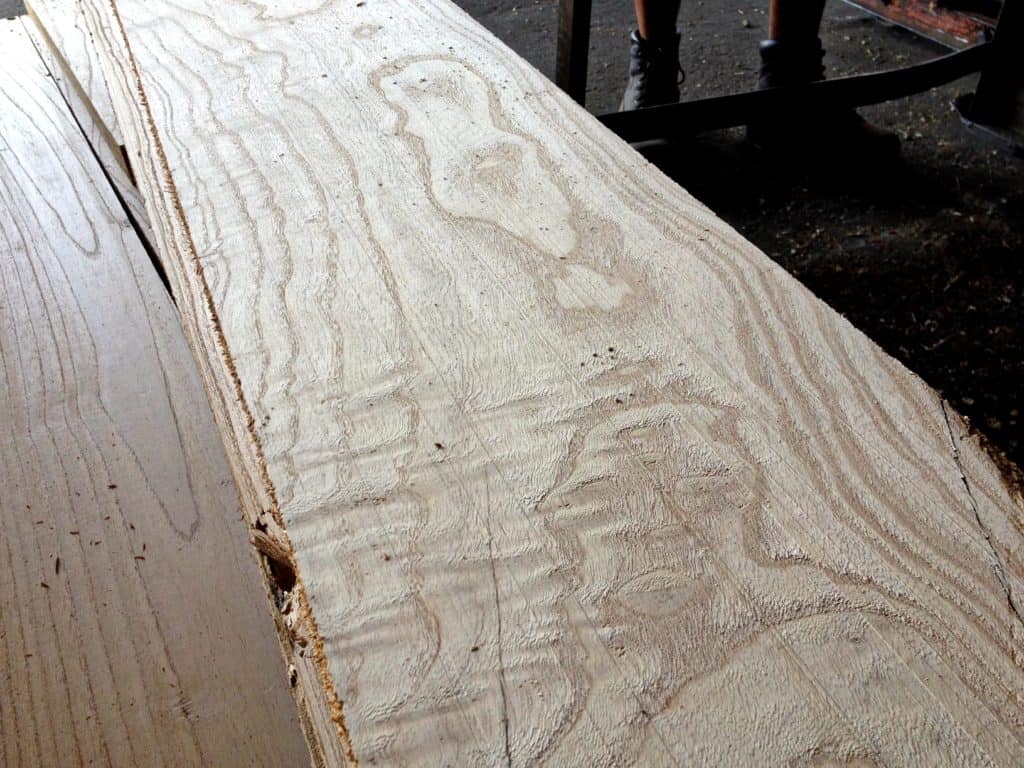
Paulownia Wood For Sale
What is Paulownia Wood?
- Scientific name: Paulownia Tomentosa/Elongata/ Kawakamii
- Alternative Names: Empresswood, Kiri
- Region of Origin: Asia, North America
- Average Dried Weight: 19 LB/cubic foot
- Janka Hardness Rating: 290
- Specific Gravity: .285
- IUCN Red List: No
- CITES wood: No
Paulownia wood (Empresswood, Kiri, Princess Tree or Royal Paulownia) is named after the Russian Queen Anna Pavlovna. It’s popular in woodworking communities. Also, luthiers, classical guitar making, furniture makers and turners use this lightweight wood for woodworking projects.
It has a similar grain and appearance to Sassafras.
Despite being native to China, it is grown around the world, including the United States. In the late 1990’s, plantations emerged to capitalize on its rapid-growth properties as an ecologically friendly super-tree. Unfortunately, growing fast and growing well are different things. Many of those plantations failed. Or at least failed to produce marketable lumber.
Paulownia Lumber For Sale in California, US
Although many companies & websites sell trees &/or seeds online, very few offer actual paulownia lumber for sale in the United States. Thus, woodworkers often ask where to buy paulownia wood?
In the United States this specie is not commercially sawn like oak, poplar and maple. Thus, it’s a niche wood like Sassafras or Chestnut.
Recently , we were fortunate to source Paulownia lumber sawn at the home of President Jimmy Carter & First Lady Rosalynn Carter. President Carter is an avid woodworker and actively participated in the harvest. If interested in paulownia wood for sale, specifically from the Carter ranch project please contact us.
Check out the Empresswood for sale on our eBay store.
Paulownia Lumber For Sale in California
Several years ago, we brought Paulownia wood to our California warehouse. At the time, most Paulownia (or Empresswood) lumber available for sale on the market was from Asia or Europe.
Due to its fast growing nature, many companies offered seeds or saplings for sale. Yet the inventory of actual kiln dried 4/4 lumber was limited.
Our Paulownia Controversy
When this Paulownia wood board came off our planer, controversy swept through our company. First, went sent it through the planer where it cleaned up well at just under 2 inch thickness. Next, in a moment of clarity delirium, I noticed that the grain pattern bore a strange resemblance to Homer Simpson. Thus, I pulled it aside to take pictures. I wanted confirmation that my Fatima moment was legit. My wife said it was pretty cool. Others were not so sure. Despite the naysayers, I think Homer was reaching out to me.
Not Everyone Loves Paulownia
From a woodworking standpoint, Empresswood can be difficult to machine and sand. This is due to elevated levels of silica which blunts tooling and causes grain tear out. Another challenge is the wood’s low density which can make holding screws difficult. This study by 9 Wood concludes there is a correlation between wood board density and screw holding strength. I question whether such a comprehensive study was required to make that connection but, regardless, it did.
From an ecological standpoint, Empresswood’s rapid growth and shade tolerance allows it to dominate sun and soil resources. Often, native species are choked out by its presence. In many jurisdictions, Paulownia is considered an invasive specie.
Paulownia is a Light Weight Wood
Empresswood’s key feature is its low density. With its ash-like grain, the low weight is surprising. Thus, it is often used for guitar builds, surfboard cores and luthiery. It is the only lightweight wood I am aware of with a well defined grain. It looks like it should be heavy but it is not. Perhaps this is why martial arts breaking boards are often made of Paulownia. According to the Asian World of Martial Arts, such boards are “a great way to inspire confidence in beginners.”
Paulownia Tree Growth Rate
Empresswood is known as a fast-growing tree, even faster than Jelutong . Hence, it is touted as a sustainable wood specie.
However, how fast does it actually grow?
Paulownia trees grow fast but there is some variation among reported tree growth rates.
According to a 2018 article by SFGate, Empresswood trees grow at a rate of up to 3 feet per year. Thus, it’s common to see trees of 30 feet height within a decade.
However, Wikipedia reports that the tree grows at a faster rate when young. Specifically, trees grow up to 20 feet in one year.
Will Paulownia Wood Rot?
Kiri will rot. However, it does so at about the same average rate as most hardwoods. Despite it’s soft texture and porous grain, Empresswood is reasonably rot resistant. According to the Wood Database, it is slightly more susceptible to inspect attacks than moisture-related rot.
Can You Stain Paulownia Wood?
Yes, you can stain Empresswood. In fact, it takes stain very well. Many luthiers use a light or natural stain. The results are visually similar to Ash.
Can You Paint Paulownia Wood?
Yes, you can paint Empresswood. However, like ash and oak, it has open porous grain. Thus, the grain should be filled before painting for a smooth uniform appearance.
Paulownia Wood for Guitars
Empresswood is an increasingly popular electric guitar body wood option. There are several reasons for this:
- Weight. Kiri is a very lightweight wood. Since working musicians often perform for hours at a time they also must carry their instruments for long periods of time. Thus, many guitarists prefer lightweight instruments to reduce the stress on muscles and joints. The guitar’s body comprises the bulk of its weight. Thus, guitars made with Empresswood bodies have low overall weight.
- Appearance. Empresswood is one of a select few wood species that mimics the look of Swamp Ash. Other ash-like species include Catalpa and Butternut. However, Empresswood has brighter sapwood, is more commercially available and faster growing than either Butternut or Catalpa.
Plantations: Growing Paulownia Trees for Profit
bee keepers from the tree blossoms.



Challenges to Growing Empresswood
Yavor and I discussed the reasons why some Paulownia timber operations have failed. We identified a few factors, specific to Empresswood.
- Lack of capital.
- Inexperience with plantation production.
- Fast potential returns on investment.
- Unrealistic expectations.
In short, the idea of turning a quick profit occasionally lures unqualified parties into timber ventures. Most tree species do not grow fast enough to bring timber to market fast. However, Paulownia does.
This Paulownia Lumber looks like Homer Simpson
In fact, Homer Simpson appeared ingrained in our figured Paulownia wood in 2014. For the record, I have not seen Homer Simpson grain on any other wood before. Accordingly, this is not a recurring fantasy on my part.
Empresswood often shows curl figure, flame figure and chatoyance. Thus, it an affordable alternative to other more expensive open-grained hardwoods.
Paulownia Wood Video #1
We made this video as a test a few years back. But, I thought we posted it privately. Thus, five years later, I discovered it public with 20,000 views and several unanswered questions from people, oops! Accordingly, please excuse the lousy production quality as I thought it was a test video. Also, someone tell that dude to tuck in that shirt.
Paulownia Wood 2019 Video #2 Update
Below is an updated Empresswood video for 2019. We show a close up of the wood with end-grain views. Also, we weight the board and calculate the weight per board foot. Additionally, we review the lumber sustainability of this fast-growing specie.



Pingback: 🌳 Swamp Ash Wood - Definitive Guide - Commercial Forest Products
Pingback: SASSAFRAS Lumber - Commercial Forest Products
Pingback: AYOUS LUMBER | OBECHE WOOD | WAWA | SAMBA - Commercial Forest Products
Pingback: Jelutong Lumber: Amazing Asian Wood! 2022 - Commercial Forest Products